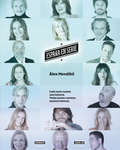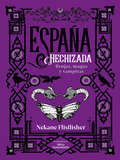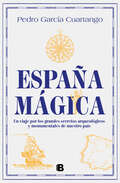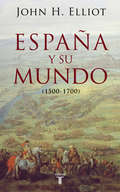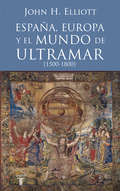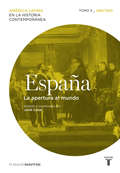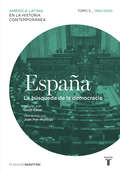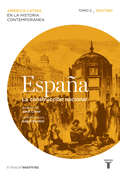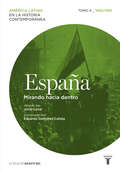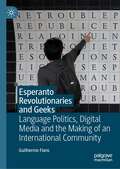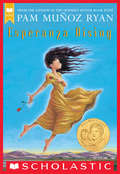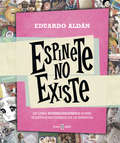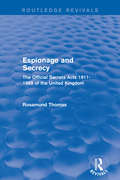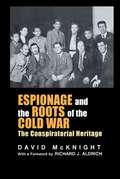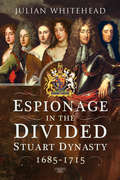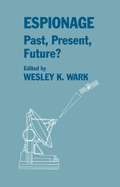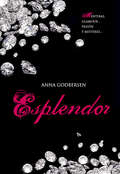- Table View
- List View
España en serie. Cada serie cuenta una historia y todas juntas cuentan nuestra historia
by Álex MendíbilUn viaje a través del tiempo, la realidad y la ficción. Todas las series cuentan una historia y todas juntas cuentan nuestra historia. España en serie parte de un trabajo documental minucioso elaborado por Canal + durante un año y medio de producción, con más de 90 entrevistas a algunas de las actrices, actores, guionistas, directores y productores de televisión más importantes de las últimas décadas. Este libro reconstruye y amplía ese valioso material, que acapara los principales acontecimientos históricos y sociales de la ficción televisiva española, por y para los amantes de las series. La historia de España se cuenta a lo largo de estas páginas desde una nueva óptica, con un peculiar orden cronológico que empieza en Hispania para llegar a las series del futuro como Plutón BRB Nero, permitiendo así un análisis horizontal de cada época. Críticas de televisión, testimonios de los artistas, de los profesionales y un poderoso material gráfico completan un estudio pormenorizado y exquisito. De forma simultánea se alza en España en serie una visión sociológica ya que la interpretación de los acontecimientos varía en función de la década y de la situación del país. ¿Cómo se veía la España de los Reyes Católicos en los años del destape o de la movida y cómo se ve ahora con Isabel? ¿Cómo eran los personajes de las series de la Transición y cómo los ve Cuéntame? Gracias al oficio y a la prosa de Álex Mendíbil la lectura de este libro se convierte en una gratificante experiencia, en un recuerdo de los mejores momentos vividos enfrente del televisor. Un recorrido por más de 50 años de historia de la televisión y 23 siglos de historia de España, un viaje a través del tiempo, la realidad y la ficción. Los protagonistas han dicho... «La que llega a todos: esa es la serie buena». Antonio Resines «La teleme llevó a dedicarme a ser actriz». Carmen Machi «La ficción llegó para quedarse y se va a quedar. El público demanda cosas con las que se sienta identificado». Emilio Aragón «Hay momentos de éxtasis en la tele». Javier Cámara «Tenemos necesidad de conocer nuestra propia Historia». Josefina Molina «El espectador, finalmente, lo que tiene que hacer es conmoverse con lo que aparece por la tele». Juan Echanove «Somos la última generación que empezamos en blanco y negro. Y cuando desaparezcamos, ya sólo quedarán los archivos». José Sancho «Yo un día abrí El País y ponía que los tres personajes más populares de España eran Letizia Ortiz, Fernando Alonso y Fernando Tejero y a mí aquello me horrorizó». Fernando Tejero «España en serie cuenta la historia de un país a través de una nueva óptica y con un peculiar orden cronológico». El Siglo de Europa Reseñas: «Sobre emociones e historia, aunque contemporánea, gira el volumen de España en serie, escrito por Álex Mendíbil con motivo del programa del mismo título emitido recientemente por Canal + y en el que se recoge el archivo de la memoria para contar la historia de España en series». Diario de Noticias
España hechizada: Brujas, magas y vampiras
by Nekane FlisflisherBrujas, magas, vampiras y todo tipo de seres malditos, enclaves ocultos y misterios paranormales sin resolver de nuestro país. Después de descubrir las historias más terroríficas y los casos reales más espeluznantes de los misterios más sonados de España, llega un nuevo volumen de la mano de la autora para conocer otros casos relacionados con brujas, vampiras y todas las leyendas mitológicas españolas más aterradoras. Un escalofriante viaje por las leyendas, mitos y criaturas más oscuras de España.
España mágica: Un viaje por los grandes secretos arqueológicos y monumentales de nuestro país
by Pedro García Cuartango¿Qué hay de mito y de verdad en los secretos que esconde la España mágica? ¿Es cierto que en Toledo se encuentra escondido el palacio de Hércules? ¿O que en Fisterra, custodiado por serpientes, se oculta el sepulcro de una bruja? ¿Realmente los fenicios levantaron en Sancti Petri de Cádiz, un recinto sagrado hace más de treinta siglos? ¿Y de verdad una legión romana se negó a cruzar el cauce río Limia en Orense temiendo perder la memoria? Nuestra identidad no se puede comprender sin indagar en nuestras raíces, esas raíces tan profundas que abarcan la Iberia megalítica, la celta, la fenicia, la griega, la romana y la medieval y que el destacado periodista Pedro García Cuartango nos descubre y acerca en estas páginas. España mágica es el resultado de una investigación colosal y una invitación a viajar y admirar los paisajes de leyenda, lugares de culto, edificios, iglesias y tradiciones que son una muestra viva de lo que fueron nuestros ancestros. Una guía -fascinante, culta y alejada de las rutas turísticas clásicas- para conocer la verdadera historia de nuestro país.
España y su mundo (1500-1700)
by John H. ElliottLos ensayos reunidos en este volumen ilustran algunos temas y diversos problemas surgidos del interés del autor por la historia de Europa, especialmente del mundo hispánico, en los siglos XVI y XVII. <P><P>En su calidad de complemento de los otros libros escritos por John Elliott, estos ensayos son indispensables para comprender la obra del gran hispanista británico. Mediante una brve introducción a cada una de las secciones en que está dividido este libro, el autor explica las circunstancias que le movieron a escvribir cada ensayo y la forma en que se relacionan con uno u otr de sus libros. <P>La primera parte, «El mundo americano», explora los vínculos entre España y sus posesiones americanas; la segunda, «El mundo europeo», va más allá de Castilla o de Cataluña para considerar la Europa de los siglos XVI y XVII en su conjunto. En la tercera parte, «El mundo de la Corte», Elliott analiza el mundo cortesano de los Habsburgo españoles y la siempre difícil relación entre el mundo de la política y el de las letras. <P>Finalmente, la cuarta parte está dedicada a la trascendental «cuestión de la decadencia» de España.
España, Europa y el mundo de ultramar (1500-1800)
by John H. ElliottJohn H. Elliott, el más prestigioso hispanista británico, reflexiona con estos ensayos, charlas y artículos sobre la política, la cultura y las ideas en Europa y el mundo colonial. Autor de algunos de los trabajos más influyentes sobre el mundo hispánico, Elliott siempre ha sabido analizar la historia de España y el mundo hispánico con una mirada original y profunda, y es autor de algunos de los trabajos más influyentes en este campo. Este volumen recoge escritos que reflejan sus investigaciones más recientes y su pensamiento sobre la política, el arte, la cultura y las ideas en Europa y el mundo colonial entre 1500 y 1800. El libro contiene catorce ensayos, charlas y artículos de impresionante calado y frescura, escritos con el característico brío de Elliott. Organizado en torno a tres ejes -los comienzos de la Europa moderna, la expansión europea en ultramar y la obra y contexto histórico de El Greco, Velázquez, Rubens y Van Dyck-, este volumen ofrece una excelente visión de conjunto de los temas que han centrado el interés de Elliott a lo largo de una carrera distinguida por su brillantez y espíritu innovador. Reseña:«Elliott es infatigable en su investigación, global en su visión, magistral en la organización del material e infalible identificando las evidencias más reveladoras o representativas. En resumen, su labor académica es lo más cercano a la perfección que se puede encontrar.»Felipe Fernández-Armesto
España, Europa y el mundo de ultramar (1500-1800)
by John H. ElliottJohn H. Elliott, el más prestigioso hispanista británico, reflexiona con estos ensayos, charlas y artículos sobre la política, la cultura y las ideas en Europa y el mundo colonial. Autor de algunos de los trabajos más influyentes sobre el mundo hispánico, Elliott siempre ha sabido analizar la historia de España y el mundo hispánico con una mirada original y profunda, y es autor de algunos de los trabajos más influyentes en este campo. Este volumen recoge escritos que reflejan sus investigaciones más recientes y su pensamiento sobre la política, el arte, la cultura y las ideas en Europa y el mundo colonial entre 1500 y 1800. El libro contiene catorce ensayos, charlas y artículos de impresionante calado y frescura, escritos con el característico brío de Elliott. Organizado en torno a tres ejes -los comienzos de la Europa moderna, la expansión europea en ultramar y la obra y contexto histórico de El Greco, Velázquez, Rubens y Van Dyck-, este volumen ofrece una excelente visión de conjunto de los temas que han centrado el interés de Elliott a lo largo de una carrera distinguida por su brillantez y espíritu innovador. Reseña:«Elliott es infatigable en su investigación, global en su visión, magistral en la organización del material e infalible identificando las evidencias más reveladoras o representativas. En resumen, su labor académica es lo más cercano a la perfección que se puede encontrar.»Felipe Fernández-Armesto
España. La apertura al mundo. Tomo 3 (1880-1930)
by Varios AutoresTomo III de España en la Colección América Latina en la Historia Contemporánea. España salió, en la década de 1870, del ensimismamiento que habían provocado las guerras civiles del siglo XIX. Modernidad y tradición iban a dialogar en permanencia entre 1875 y 1930. Este periodo coincide con los regímenes de la Restauración #monárquico y de orden, liberal aunque no totalmente democrático# y de la dictadura de Primo de Rivera. En este volumen, el tercero de una serie de cinco dedicados a la historia contemporánea de España, se analiza desde múltiples ángulos, desde el político al cultural pasando por el internacional, el económico, el demográfico o el social, esta compleja etapa. Este toma está coordinado por Jordi Canal. La colección América Latina en la Historia Contemporánea es uno de los proyectos editoriales más importantes de las últimas décadas y una aportación original y novedosa a la historiografía sobre América Latina en la que han participado más de 400 historiadores de diversos países. Presenta una visión plural y accesible de la historia contemporánea de las naciones latinoamericanas #incluyendo aquellas otras, europeas o americanas, que más han aportado a su materialización# y revela las claves políticas, sociales, económicas y culturales que han determinado su trayectoria y el lugar en el mundo que hoy ocupan. * Premio de la revista La Aventura de la Historia a la mejor iniciativa editorial
España. La búsqueda de la democracia. Tomo 5 (1960-2010)
by Varios AutoresTomo V de España en la Colección América Latina en la Historia Contemporánea. Entre 1960 y los comienzos del siglo XXI, España ha experimentado transformaciones profundas que se relatan en este volumen. La fundamental ha sido la pérdida gradual de su soberanía económica, y por lo tanto el menoscabo de su soberanía política, mediante su incorporación al proceso de integración europea. Condición previa fue la conflictiva transición desde un Estado autoritario, uniformizador y nacional-católico a una monarquía democrática, descentralizada y culturalmente plural. El proceso de integración europea se ha desarrollado en interacción con la globalización, que ha reforzado las relaciones entre España y el espacio latinoamericano. Integración y globalización han contribuido a cambios que la inmensa mayoría de la población calificaría de positivos pero están también en el origen de los retos a los que se enfrenta el país en la actualidad. La colección América Latina en la Historia Contemporánea es uno de los proyectos editoriales más importantes de las últimas décadas y una aportación original y novedosa a la historiografía sobre América Latina en la que han participado más de 400 historiadores de diversos países. Presenta una visión plural y accesible de la historia contemporánea de las naciones latinoamericanas -incluyendo aquellas otras, europeas o americanas, que más han aportado a su materialización- y revela las claves políticas, sociales, económicas y culturales que han determinado su trayectoria y el lugar en el mundo que hoy ocupan. Distinciones:Premio de la revista La Aventura de la Historia a la mejor iniciativa editorial.
España. La construcción nacional. Tomo 2 (1830-1880)
by Varios AutoresTomo II de España en la Colección América Latina en la Historia Contemporánea, dirigido por Jordi Canal y coordinado por Isabel Burdiel.La quiebra definitiva de la monarquía absoluta, la consolidación del liberalismo y el ensayo de sus diferentes propuestas se produjeron en España entre 1833 y 1874. La pérdida del grueso del imperio americano implicó el reacomodo de España como potencia europea de segundo orden dentro del bloque liberal liderado por Francia e Inglaterra. Los retos que se plantearon en este periodo, y las variadas soluciones que se procuraron, formaron parte del crucial proceso transnacional de gobernabilidad posrevolucionaria en el mundo occidental.La colección América Latina en la Historia Contemporánea es uno de los proyectos editoriales más importantes de las últimas décadas y una aportación original y novedosa a la historiografía sobre América Latina en la que han participado más de 400 historiadores de diversos países. Presenta una visión plural y accesible de la historia contemporánea de las naciones latinoamericanas ?incluyendo aquellas otras, europeas o americanas, que más han aportado a su materialización? y revela las claves políticas, sociales, económicas y culturales que han determinado su trayectoria y el lugar en el mundo que hoy ocupan.
España.: Mirando hacia dentro. (América Latina en la Historia Contemporánea #4)
by Varios AutoresTomo IV de España en la Colección América Latina en la Historia Contemporánea. España salió, en la década de 1870, del ensimismamiento que habían provocado las guerras civiles del siglo xix. Modernidad y tradición iban a dialogar en permanencia entre 1875 y 1930. Este periodo coincide con los regímenes de la Restauración #monárquico y de orden, liberal aunque no totalmente democrático# y de la dictadura de Primo de Rivera. En este volumen, el tercero de una serie de cinco dedicados a la historia contemporánea de España, se analiza desde múltiples ángulos, desde el político al cultural pasando por el internacional, el económico, el demográfico o el social, esta compleja etapa. Este toma está coordinado por Eduardo González Calleja. La colección América Latina en la Historia Contemporánea es uno de los proyectos editoriales más importantes de las últimas décadas y una aportación original y novedosa a la historiografía sobre América Latina en la que han participado más de 400 historiadores de diversos países. Presenta una visión plural y accesible de la historia contemporánea de las naciones latinoamericanas #incluyendo aquellas otras, europeas o americanas, que más han aportado a su materialización# y revela las claves políticas, sociales, económicas y culturales que han determinado su trayectoria y el lugar en el mundo que hoy ocupan. * Premio de la revista La Aventura de la Historia a la mejor iniciativa editorial
Españoles en el holocausto (Ed. actualizada)
by David W. PikeEl presente libro describe la experiencia del gran contingente español confinado en uno de los más terribles campos de concentración nazis, el complejo de Mauthausen. Entre los cientos de miles de prisioneros enviados a este campo, los siete mil españoles que llegaron allí eran republicanos refugiados en Francia que habían luchado en la Guerra Civil y que, tras la invasión nazi, fueron arrestados por las tropas alemanas. Su historia sirve en parte para presentarnos un microcosmos de la experiencia colectiva, pero es al mismo tiempo una experiencia única. Esta cuarta edición ha sido revisada por el autor y ampliada con dos anexos: una lista de los españoles de Mauthausen fallecidos por causas no naturales y una extensa coda que incorpora sus avances en la investigación durante los últimos diez años.«Con este solo libro se aprende más que comprendiendo la mayoría de los libros que hay en el mercado.»Gabriel Jackson
Españoles en el holocausto: Vida y muerte de los republicanos en Mauthausen (Arena Abierta Ser.)
by David W. PikeEl presente libro describe la experiencia del gran contingente español confinado en uno de los más terribles campos de concentración nazis, el complejo de Mauthausen. Entre los cientos de miles de prisioneros enviados a este campo, los siete mil españoles que llegaron allí eran republicanos refugiados en Francia que habían luchado en la Guerra Civil y que, tras la invasión nazi, fueron arrestados por las tropas alemanas. Su historia sirve en parte para presentarnos un microcosmos de la experiencia colectiva, pero es al mismo tiempo una experiencia única. Esta cuarta edición ha sido revisada por el autor y ampliada con dos anexos: una lista de los españoles de Mauthausen fallecidos por causas no naturales y una extensa coda que incorpora sus avances en la investigación durante los últimos diez años. Opinión:«Con este solo libro se aprende más que comprendiendo la mayoría de los libros que hay en el mercado.»Gabriel Jackson
Esperanto Revolutionaries and Geeks: Language Politics, Digital Media and the Making of an International Community
by Guilherme FiansThis book explores how Esperanto – often regarded as a future-oriented utopian project that ended up confined to the past – persists in the present. Constructed in the late nineteenth century to promote global linguistic understanding, this language was historically linked to anarchism, communism and pacifism. Yet, what political relevance does Esperanto retain in the present? What impacts have emerging communication technologies had on the dynamics of this speech community? Unpacking how Esperanto speakers are everywhere, but concentrated nowhere, the author argues that digital media have provided tools for people to (re)politicise acts of communication, produce horizontal learning spaces and, ultimately, build an international community. As Esperanto speakers question the post-political consensus about communication rights, this language becomes an ally of activism for open-source software and global social justice. This book will be of relevance to students and scholars researching political activism, language use and community-building, as well as anyone with an interest in digital media more broadly.
Esperanza Rising (Scholastic Gold)
by Pam Muñoz RyanEsperanza Rising joins the Scholastic Gold line, which features award-winning and beloved novels. Includes exclusive bonus content!Esperanza thought she'd always live a privileged life on her family's ranch in Mexico. She'd always have fancy dresses, a beautiful home filled with servants, and Mama, Papa, and Abuelita to care for her. But a sudden tragedy forces Esperanza and Mama to flee to California and settle in a Mexican farm labor camp. Esperanza isn't ready for the hard work, financial struggles brought on by the Great Depression, or lack of acceptance she now faces. When Mama gets sick and a strike for better working conditions threatens to uproot their new life, Esperanza must find a way to rise above her difficult circumstances-because Mama's life, and her own, depend on it.
Espiando a un Duque: Libro 1, Herederas Encubiertas. (Herederas Encubiertas. #1)
by Erica MonroeELLA QUIERE VENGANZA Cuando la intelectual Vivian Loren se convierte en la institutriz de la adinerada familia Spencer, está en búsqueda de pistas sobre el asesinato de su hermano, sin romance. Pero Vivian no contaba con una cosa: James Spencer, el intrépido Duque de Abermont, que tiene su propio pasado tortuoso. ÉL NECESITA UNA ESPOSA Como líder de la agencia de inteligencia de élite británica, James no puede tolerar el escrutinio que el Matrimonio Mart traería a su familia una vez que inicie la Temporada. Tras descubrir que la venganza de Vivian la ha convertido en un peón en una trampa de los espías más letales de Napoleón, James se da cuenta de que pueden ayudarse el uno al otro, Ella será su duquesa, y el la mantendrá a salvo. Lo que comenzó como un matrimonio por conveniencia rápidamente se convierte en nada más que el espía enemigo se acerca hacia ellos. Cuando los oscuros secretos de marido y mujer se van revelando, el amor puede ser la misión más peligrosa de todas.
Espinete no existe: Un libro nostalgicómico sobre nuestros recuerdos de la infancia
by Eduardo Aldán¿Te has preguntado alguna vez por qué los clicks de Playmobil no tienen codos? ¿Habías oído hablar de Torrevieja antes de ver el Un, dos, tres? ¿Todavía consideras al bollito Pantera Rosa como repostería fina? Si te has planteado alguna de estas cuestiones, es que pasaste tu infancia en los setenta o los ochenta y, llegado el momento, tuviste que afrontar la mayor decepción de todas: darte cuenta de que ESPINETE NO EXISTE.Eduardo Aldán te hará mas llevadero este trauma invitándote a revivir las emociones de tu infancia a través de las pequeñas cosas que han marcado a varias generaciones de españoles: el material escolar, las chucherías, los juguetes o la televisión.Después de batir récords con su espectáculo ESPINETE NO EXISTE, con ocho temporadas consecutivas y casi un millón de espectadores, Eduardo Aldán refleja y amplía la magia de su show en 240 páginas totalmente ilustradas llenas de ingenio, ironía, humor, ternura y nostalgia.
Espionage and Counterintelligence in Occupied Persia (Iran): The Success of the Allied Secret Services, 1941-45
by Adrian O’SullivanThe sequel to Nazi Secret Warfare , which portrayed the catastrophic failure of Germany's clandestine services in Persia (Iran) during the Second World War. By contrast but based on equally solid archival evidence, this companion volume tells the other side of the same fascinating story, introducing us to spies, spycatchers, and spymasters.
Espionage and Secrecy: The Official Secrets Acts 1911-1989 of the United Kingdom (Routledge Revivals)
by Rosamund ThomasThis prize-winning book, first published in 1991, provides a detailed legal account of the development of the UK Official Secrets Acts 1911-1989. In particular, the Espionage section (s.1) of this criminal law is analysed carefully, illustrated by leading cases of UK spies prosecuted under this section, particularly during the 1980’s — including MI5 officer Michael Bettaney and Geoffrey Prime who worked at GCHQ. The author also examines problems of evidence in espionage prosecutions, and the consent of the Attorney-General in cases under the Official Secrets Acts. This book remains the definitive treatise on the UK Official Secrets Acts, especially concerning the espionage provisions.
Espionage and the Roots of the Cold War: The Conspiratorial Heritage (Studies in Intelligence)
by David McKnightFrom the 1930s to the 1950s a large number of left-wing men and women in the USA, Britain, Europe, Australia and Canada were recruited to the Soviet intelligence services. They were amateurs and the reason for their success is intriguing. Using Soviet archives, this work explores these successes.
Espionage in the Divided Stuart Dynasty, 1685–1715: 1685-1715
by Julian WhiteheadA historian and intelligence expert explores intrigue, betrayal, and spying in Stuart England after the Glorious Revolution of 1688.King James II was the Catholic king of a Protestant nation. Though he had inherited a secure crown, he would soon find himself isolated and flee to France in exile. His throne was seized by his Protestant son-in-law William and daughter Mary. For James it was a personal tragedy of King Lear proportions; for most of his subjects it was a Glorious Revolution that saved his kingdoms from popery.Over the next hundred years James and his descendants would attempt to win back the crown with French support and conspiring with British Jacobites and Tories. In Espionage in the Divided Stuart Dynasty, Julian Whitehead charts the inner workings of government intelligence during this unstable period. His narrative sheds light on the murky world of spies and double agents at a time of when many politicians and peers tried to keep a foot in both camps.
Espionage: Past, Present and Future? (Studies in Intelligence)
by Wesley K. WarkHighlights of the volume include pioneering essays on the methodology of intelligence studies by Michael Fry and Miles Hochstein, and the future perils of the surveillance state by James Der Derian. Two leading authorities on the history of Soviet/Russian intelligence, Christopher Andrew and Oleg Gordievsky, contribute essays on the final days of the KGB. Also, the mythology surrounding the life of Second World War intelligence chief, Sir William Stephenson, The Man Called Intrepid', is penetrated in a persuasive revisionist account by Timothy Naftali. The collection is rounded off by a series of essays devoted to unearthing the history of the Canadian intelligence service.
Espiões, Espionagem e Operações Secretas - Da Grécia Antiga à Guerra Fria
by Michael Rank Shana Marcele Oliveira e SilvaDo autor do best-seller #1 History's Greatest Generals, chega um novo e empolgante livro sobre os maiores espiões que existiram e como os seus atos de espionagem e operações secretas mudaram o curso da história. Quer seja Enéas, o Tático, que criou a ciência militar ocidental; Francis Walsingham, espião da rainha Elizabeth que frustrou inúmeras tentativas de assassinato e teceu uma rede internacional de espionagem internacional no início do colonialismo europeu; ou Richard Sorge, o espião beberrão alemão para os soviéticos cuja interceptação de inteligência militar preveniu o colapso do exército russo na Segunda Guerra Mundial, cada um desses espiões teve um grande impacto na sociedade moderna. Este livro explora as vidas e os tempos dos dez maiores espiões, ou redes de espionagem, na história. Alguns assumiram status lendário, como Mata Hari, a dançarina exótica e cortesã da Primeira Guerra Mundial que compartilhou as camas de tantos oficiais franceses e alemães que não pôde evitar tornar-se uma agente dupla. Outros espionavam por pura convicção ideológica, como George Koval, um espião americano nascido em Iowa que vazou segredos nucleares para a União Soviética, acelerando em anos o programa nuclear da Rússia e tornando possível a corrida armamentista da Guerra Fria. Outros, ainda, atingiram um nível de adoração quase religiosa - Nathan Hale, o espião da era da Revolução Americana, teve uma carreira muito curta, mas se tornou o primeiro mártir da América e um estimado símbolo nacional. Qualquer que fosse sua razão para a espionagem, estes espiões representaram a mão invisível do poder governamental. Suas vidas eram envoltas em mistério - e muitos tiveram origens tão complicadas que nós ainda desconhecemos sua verdadeira lealdade, se eles tiveram alguma. Mas apesar de suas vidas enigmáticas, eles foram a mão invisível que ajudou a dirigir o curso da história.
Esplendor (Latidos #Volumen 4)
by Anna GodbersenLlega el esperado desenlace a Latidos, Rivales y Envidia: romanticismo, intrigas y glamur. Manhattan, 1900. Las jóvenes de la alta sociedad persiguen sus sueños envueltas en lujo y glamur, como princesas de un nuevo mundo. Pero Diana y Elisabeth Holland saben bien que este mundo de belleza y elegancia es solo una máscara tras la que se ocultan traiciones, mentiras y luchas de poder. Y ahora, cada una a su manera, romperán las encorsetadas normas de su clase para intentar alcanzar la felicidad... y el amor verdadero.
Espuelas de papel
by Olga MerinoEspuelas de papel es una narración llena de imágenes y emoción, donde el amor imposible, la traición y los deseos de los protagonistas nos trasladan a una época e silencio, derrota y esfuerzo.«...siempre hacia adelante, siempre, aunque tengas que picar el vientre del caballo con espuelas de papel.»En los años cincuenta, Juana, una joven andaluza, emigra con su familia a Barcelona huyendo del hambre y la pobreza. Como una cenicienta de posguerra, entra a servir en casa de Salud Monterde y sus hijas, enriquecidas gracias a un asunto turbio. Cuando la vida desvanezca sus ilusiones, el amor de Liberto, el anarquista perseguido, será su único refugio.Olga Merino se revela en esta novela dueña de un lenguaje original y fuerte, de una expresividad que ahonda en la humanidad de los personajes, que viven acosados por las voces de la memoria.
Espérame en el infierno
by Óscar SerranoIntriga y espionaje al más puro estilo de clásicos como Forsyth, Fleming o Le Carré. <P><P>Una trepidante historia de valentía, en la que una delgada línea separa la frontera entre el bien y el mal. <P> A finales de los años noventa, los asesinatos de dos agentes durante una operación secreta en Roma sacuden el CNI. <P>El asunto permanece enterrado hasta que la vigilancia sobre un diplomático ruso, miembro del FSB, revela algo turbio detrás de aquella tragedia. <P>Samuel, un atrevido y eficaz espía, integrante de aquel equipo, quiere respuestas. Iniciará una investigación que le llevará hasta lo más profundo del crimen organizado internacional. <P>Pronto entenderá que en las cloacas del estado no hay lugar para la justicia. Entonces Samuel elegirá venganza.
